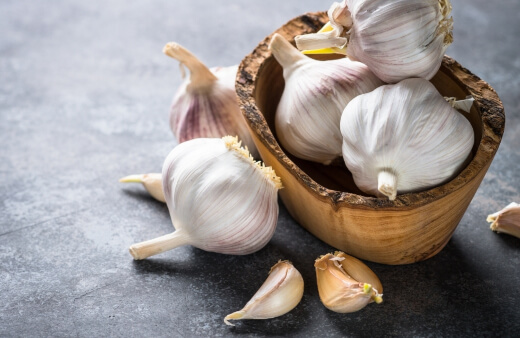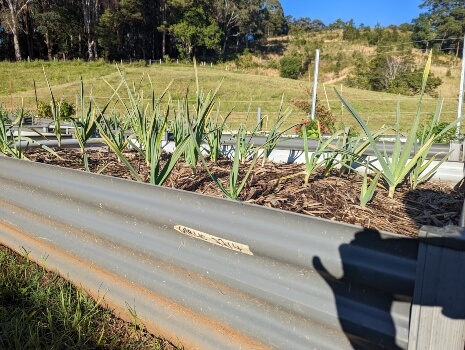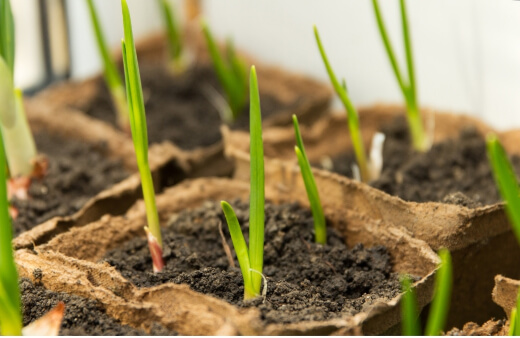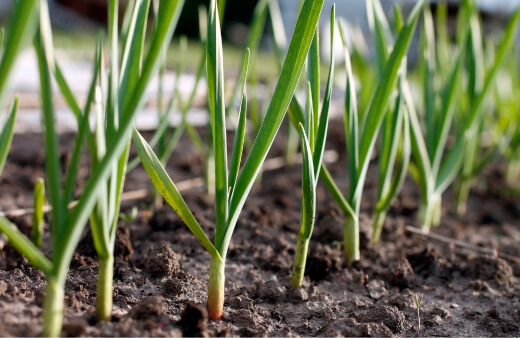Do you want to know how to grow garlic at home? Garlic is one of the best known ancient bulbous vegetables, and today it forms part of many delectable dishes and cuisines.
Believed to be one of the second oldest medicines in the world, Garlic has been studied to help prevent heart disease and cancer. Best enjoyed roasted, sliced, grated or crushed; this hardy vegetable is an ideal option to add to your home vegetable garden.
Follow our grow guide to make sure you know exactly how to grow Garlic at home.
More...
What is Garlic and Its Varieties

Garlic is a good choice of crop for both beginner and experienced growers. It requires little space and little effort, as long as you can guarantee fresh soil and the right choice of cloves to grow.
When choosing a variety of Garlic to grow, there are a few that you can choose from. These include:
- Soft-Neck Garlic. This is the most common type of Garlic you’ll find at your local supermarket. This variety produces the largest amount of cloves. This variety is best suited to cooler climate areas.
- Hard-Neck Garlic. This variety is far hardier than soft-neck Garlic. However, it does produce far fewer cloves. This variety does produce a flower stalk, which needs to be cut down in order to encourage bulbous growth.
- Elephant Garlic. Is another variety, which is slightly harder to come by. This variety grows a very large bulb but has a far milder taste as opposed to soft- and hard-neck varieties.
What is the Best Garlic to Grow in Australia?
Between the soft – and hard-neck varieties, there are lots of different kinds of Garlic you can choose to grow. Here are a few of our favourites:
- Australian White. This soft-neck variety is a classic, white-skinned bulb. It does require a colder winter and hot, dry summer. This variety is most suitable for Victoria and NSW.
- Glenlarge. This soft-neck variety has a curious purple tinge. It’s suitable for warmer areas and offers a mild flavour for cooking.
- Italian White. Another white-skinned variety produces up to 17 cloves per bulb.
- Monaro Purple. This is a purple-tinged hard-neck variety with a sweet and nutty flavour.
How to Grow Garlic in Australia

A key factor for growing Garlic is that you need a fresh spot in which it will grow. Any soil which has recently grown Garlic or any vegetable in the onion family.
This is why many first-time growers opt for raised beds or container growing. Be sure to pick a warm and sunny spot for ideal growth.
Cloves can be planted either directly into the ground or into a container. Before planting, be sure to prepare the soil by:
- Choosing a fertile, well-draining potting medium if grown in a container.
- Clear any stones or debris from the top layer of soil if growing in the ground.
- Support the soil with a good compost mix, preferably with some nutrient-rich manure.
- Apply a slow-release, 10-10-10 fertiliser to the soil.
How to Plant Garlic
Depending on the variety you choose to grow, you will need to plant during spring or fall. For areas like Queensland and New South Wales, March to Early April is the ideal time.
This will mean that your Garlic will be ready for harvest by September. When planting garlic, separate the individual cloves. Try to choose the fatter outer cloves.
Plant the cloves, pointy end up, directly into the soil. Cloves should be spaced a minimum of 10 – 15 cm apart. Ensure that cloves are sitting at least 3 – 5 cm beneath the surface of the soil.
Using your hands, gently firm the soil down. Once you’re done planting, it is advised to apply a good layer of mulch over the entire area of soil.
Especially in cold-prone areas, this will protect the roots and control any unruly weeds. It is also important to note that certain bird species tend to enjoy picking out the bulbs from the soil.


Get Your Free Guide:
Master Growing Australian Natives eBook
A Must Have Complete Guide for Every Australian Garden
Get Your Free Guide:
Master Growing Australian Natives eBook
A Must Have Complete Guide for Every Australian Garden
If growing in your garden, it is recommended to place some bird netting or horticultural fleece over the young plants. This can be removed once the shoots grow to 5 cm tall.
Growing Garlic in a Container

As mentioned, growing Garlic in a container is a great way to guarantee unaffected soil, especially for those who have perhaps moved into a new home and are unsure of what may have previously grown in the soil.
In a container, be sure to treat the soil with some multi-purpose compost.
For a smaller yield, a 15cm pot will do. Otherwise, a 30 cm pot will also work. For 15 cm pots, avoid planting more than 3 cloves. In 30 cm pots, you can plant as many as 6 cloves.
How to Care for Garlic
Garlic won’t need much additional care once planting beyond the occasional watering. You can water fairly regularly throughout the spring and summer.
In the early growing stages, as you notice it beginning to grow small shoots, it will need a little bit of support. It’s recommended to add a high-nitrogen fertiliser at this time.
Once your Garlic stops producing leaves and begins to yellow, it is a sign that it is reaching maturity, meaning you can stop watering and care altogether. At this time, you can also remove any mulching, leaving your garlic plenty of space and light to grow.
Some varieties, like hard-neck Garlic, produce flower stalks. It is recommended to cut those down a few centimetres, so all the growing energy is spent on producing a larger bulb.
If you’ve planted your Garlic quite late and hope to speed up the time of harvest, it is possible to bend over the tops of the stems, which will encourage your Garlic to dry out.
Harvesting and Storing Garlic

Although harvesting garlic depends slightly on climate, a good signifier that your Garlic is ready for harvest is when the leaves begin to turn brown.
You can simply dig up the bulbs from the soil, taking care not to bruise any of the bulbs. Thereafter, you will need to leave your Garlic out to dry for at least 2 to 3 weeks.
Choose a shady spot with good air circulation. Avoid getting the bulbs wet by any means, as this can cause mould to grow. You can consider trying the Garlic into bunches to dry or braiding the leaves together.
Alternatively, you can also cut the stem a few centimetres above the bulb. However, make sure that there is plenty of airflow, even to the base of the bulb.
Check your curing garlic regularly. Should you notice any starting to sprout, use them immediately.
To use your Garlic, you can either roast them whole or separate and peel the individual cloves for use. You can crush, slice, chop or roast them and add that extra flavour punch to a variety of meals.
Here are some incredible garlic recipes for you to try.
Garlic Growing Problems

Besides the bird problem, Garlic has very little issues when grown in the right conditions. Many available species are also treated to be resistant to certain pests and diseases. Nonetheless, some gardeners do experience issues with:
- White Onion Rot. This form of rot is incredibly hard to detect, and you’ll probably only notice it once it’s too late. This rot creates a white, fluffy fungus on the bulb.
Unfortunately, there is no control for this fungus once it has arisen. More so, as it is a soil-borne disease, it will affect any crop that grows in the soil thereafter. It is recommended to remove and burn any affected crops. - Leek Rust. Presented as little orange pustules produced all along with the leaves of your Garlic, this fungal infection usually only occurs in very wet weather. While it won’t affect the bulb, it is recommended to harvest immediately to prevent the spread to any of your other plants.
Other Common Growing Garlic Questions

Can You Plant Cloves From The Grocery Store?
While it is possible, it is not recommended. Most of the Garlic available at stores is from regions around Asia and is usually highly treated.
Planting this kind of Garlic can result in unwanted transmissions of fungus into the soil.
Do I Peel Garlic Before Planting?
You can leave the papery skin that encompasses each individual clove, as this will not affect growth. Peeling them may also result in you damaging the clove, affecting the viability.
Can You Plant Garlic that has Sprouted?
You certainly can, as long as the sprouted-garlic are certified disease-free bulbs from a nursery.

Now You Know How to Grow Garlic at Home in Australia
Whichever kind of Garlic you choose to grow, as long as you keep it in a warm and sunny spot, and in the right soil, you should have absolute success. If you’re worried about soil quality, consider raised beds or container growing for guaranteed growth.
Garlic is absolutely easy to grow, so if you’re someone who’s interested in growing your own food, why not start with Garlic? There you have it. Everything you need to know on how to grow garlic in the comfort of your home.
Published on August 11, 2021 by Gary Clarke
Last Updated on February 20, 2024




